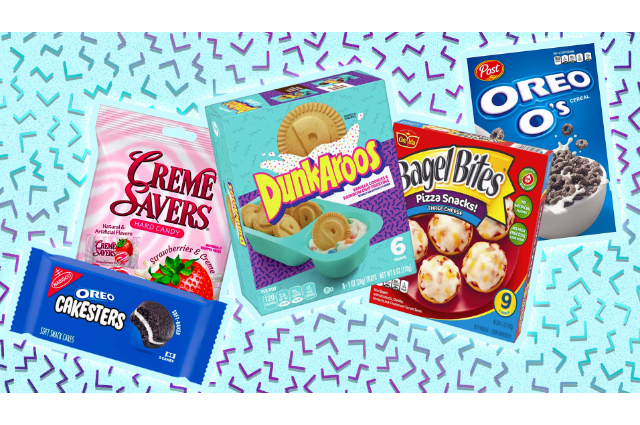
On September 16, 2024, the trio of Mr. Beast, KSI, and Logan Paul released their new food brand Lunchly that was marketed and put forth as the ‘healthier’ alternative to the much more popular and enduring Lunchables, which was introduced in 1988 and became a staple for 90s kids in the Western world. Though the reviews of Lunchly were mixed, reports of mould in the cheese and bare-minimum health directions – the whole debacle made one thing clear. Nostalgia and the urge to repackage old snacks and beverages into new products are well-known.
When the internet first became mainstream in the late 90s, it targeted the youth at the time. After all, it is the youth who are more attracted to newer technology over older generations who are cautious and keep to their comfort zone. In the present day, they have grown up and are called the ‘Millennial’ generation – essentially, 90s kids. As the current spending generation, businesses are drawn to capitalising on nostalgia and nostalgic things to keep businesses afloat. Childhood is a wonderful time of one’s life, and in the current world of the internet and every product meant to attract, the marketing around nostalgia is only becoming stronger.
Products from the 90s have a surge in internet results, and reboots of 90s properties like X-Men ’97 became smash successes due to people seeing the past through rose-coloured lenses. One of the most promoted products, however, is food. Snacks, beverages, and more seem to come back to the minds of consumers through social media platforms that share old advertisements and product placements in the movies and animation of yesteryear. The ecosystem for advertising has become prime for the older generation as they are increasingly nostalgic for a time without the internet and the bombardment of social media, while simultaneously falling into the trap of nostalgic marketing. As the last generation to remember a time without the internet, this resurgence of nostalgia seems to be a way for them to grasp what little remnants of their childhood are left behind.
Gathering of Interest
90s nostalgia gained steam around the mid-2010s with blogs and corporations like Buzzfeed creating articles about the 90s media and apparel that people missed. Reddit threads and more social media posts about missing an era soon came into being. These started small – little bites of nostalgia to be shared around with like-minded people. At first, many of these were centred around the USA and American culture, but soon, some offshoots focused on British nostalgia, South American nostalgia, Indian nostalgia and more.
While there are posts about nostalgia trips to the 80s and 70s, nothing seems to have taken the internet by storm like the 90s. A few factors could be that the people who were catered to from previous decades did not spend time on the internet as the kids who grew up in the 90s and later did. Another factor for the resurgence of 90s marketing is the fact that most of those kids have grown up with families and money of their own, making them the prime consumer base for toys and snacks that were created in the 90s, letting them share the culture with their children and other younger members of the family.
The Return of the Snacks
While some beloved snacks from the 90s and 2000s are still discontinued (R.I.P. Cadbury Bytes), corporations have taken notice of this clamouring for 90s nostalgia on the internet and have started to deliver upon their promises. Planter’s Cheez Balls were discontinued in 2006 before being brought back in 2018 due to the calls from 90s kids on the internet who missed their innovative yet unhealthy snacks that took over the world by storm.
Twinkies, too, made a comeback after many articles about it being pulled off store shelves, to be packed back in the realms of memory and out of reality. Aside from beloved snacks coming back and existing snacks putting out limited edition products that invoke the feel of the 1990s, newer products are coming onto the shelves – ones that emulate the feeling of snacks from the nineties while boasting healthy ingredients and other buzzwords that help a product take off in the current health-conscious world.
Some products have switched to advertising for both adults and children. Trix, for example, is now not just for kids. It has also been marketed towards adults who long for a simpler time when they had no responsibilities and could live under the roofs of their parents. To a degree, these products bring the consumers back to a more innocent chapter in their lives, rendering them in a state of limbo between adulthood and childhood.
Whereas some generations have grown up too quickly, the nineties were not allowed to grow up by the surrounding media and the constant nostalgia bait.
The End of Nostalgia Bait
With nostalgia taking over marketing, the result has been a constant rush of revivals, reboots and bringing things from the past without updating or making meaningful changes. Snacks are brought back without understanding that the snacks represented more than the treat – it represented a time gone by, one that cannot be brought back through sheer will and internet petitions.
Originality is the oil that runs the wheels of thought and the soul. The sheer number of nostalgic marketing campaigns is starting to take its toll on the internet, and the people are becoming immune to this sort of marketing and content, even mocking it on mainstream social media.
In the end, while nostalgia can be fun once in a while, too much of anything is never a good thing.
Sources:
